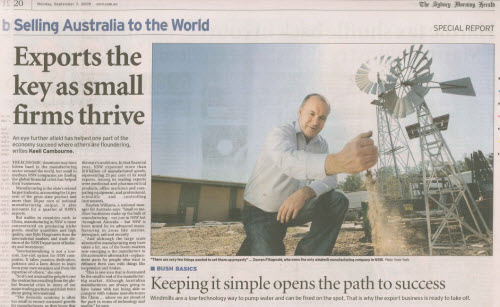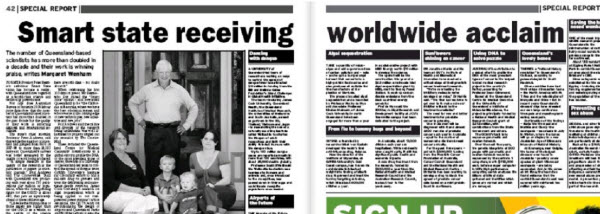After inviting SMH editor Peter Fray for an interview before publishing the results of our survey, the ACIJ was asked to present some examples of our findings of PR-driven material. One of the articles we sent Fray was the Australian Export Awards “special report” that we discussed in Emma Kemp’s story on special reports from Friday.
Here was his response:
In general, the Herald, more than any other newspaper, stands for serious journalism and has a rigorous approach to marking special reports as such and interrogating the flood of PR material which infects our industry… As for the special reports, I note that the Press Council has recently declined to consider a complaint relating to a special report on independent schools published by the Sun-Herald last month. The council noted that the material had been properly tagged as a special report and met its guidelines.
So the term special report is industry parlance for advertising feature in some editorial departments? The ACIJ decided to canvass opinion on the topic.
We raised an example that Fray had pointed out to us with the Australian Press Council’s executive secretary, Jack Herman. Herman said that the council had considered the complaint, but the “report” was deemed to be within the APC’s advertorial guidelines and did not proceed to a mediation process.
Herman told the ACIJ that the council had rewritten its guidelines for advertorial content in 2005 following an increasing number of complaints and subsequent adjudications about inadequately labelled promotional material and a “tying of editorial to advertising”.
“The Press Council’s principles say that newspapers should disclose conflicts of interests that will influence the reporting of stories, whether it’s news or commentary. Therefore, if the story has been provided by someone other than the staff of the newspaper, the newspaper should provide an identification of who that person is and what their connection is,” he said.
“If the content is generated within the normal editorial areas of the newspaper, then we’re quite happy for that. If its copy that’s been provided by an advertiser, then it needs to be labeled as to where that’s come from.”
Herman had assessed the “Independent Schools Expo” report as an example of an editorial department targeting specific advertising partners for discrete, supplementary sections of a newspaper. But what about the scenario in which journalists are writing copy tailored to the interests of the advertiser, complete with pre-selected sources? Fairfax’s presentation, pitches “strategic features” wearing the title of special reports to clients as exactly that. Here the Press Council’s position is a little less clear.
“I’d have to see the situation, I can’t make a judgement on that sort of generality,” Herman said. “The council hasn’t dealt with this in detail yet as we haven’t had a case before us where we can make the definitive statement.”
“The council is quite happy to take complaints about any of those, look at them on a case-by-case basis and make a judgement about whether the newspaper has been clear enough with its audience about what they’re getting,” said Herman.
Herman said he was satisfied that the council’s position on the issue was strong enough, but pointed out that they will be looking to overhaul all of their guidelines within the next few months, with the aim of having a stronger presence in newsroom style guides.
Fray’s and Herman’s responses to our inquiries about the labelling of promotional content presumed that the term Special Report to denote an advertising feature was self evident, although the guidelines don’t actually use the words special report. We doubt that the term is self-evident to readers, and decided to test if this was a fair assumption. We found two recent special reports (here and here) in the Courier Mail that we couldn’t find a press release for, we asked editor David Fagan whether these were advertorial features.
The first appeared to be a straight report, the second was extremely positive about the Queensland government and their role in building research.
Here’s what he said:
The first is a special report into the abject failure of the federal government’s green loans scheme. We broke the story and the story you refer to is more depth on the splash we ran that day. It was written by one of our investigative reporters Tuck Thompson and was a great piece of journalism which put us about a week ahead of the wheels coming off the scheme and then the insulation scheme.
The second is also a detailed report on the state of play in Queensland’s research industry. It was written by our higher education reporter Marg Wenham and looked at some of the research successes in the state. Nothing sinister. Just an interesting story.
… Fairfax seems to have departed from this custom by hijacking the language to call such things “special reports”. I use the term in a different way — probably as it was meant to be used.
Fairfax and News seem to have different policies. So how are readers to discern the difference? Former Age award-winning investigative journalist Bill Birnbauer, who now teaches journalism at Monash University, says that the decision is personal.
“It’s up to editors how they want to interpret those guidelines, so you’re going to get a lot of different judgements made on that. Some are a bit more assertive than others, whereas there’ll be people along the line who think it’s perfectly OK,” he said.
“I think the use of words like special feature are completely misleading to readers. The whole idea of running advertorials that look like broadsheet or tabloid copy, just another news page — is really to trick and deceive readers into believing that material has the kind of integrity and credibility that journalistic work has — and the opposite is true in my view.”
Former Age editor Mike Smith, a journalist, now executive director of Inside Public Relations says that he regularly ran promotional copy, but made it conform to his own standards.
“I called it an advertising feature. We had lots of them but I didn’t allow people to use the same fonts of the headlines — so it had to look different and be clearly distinguished from editorial copy,” he said.
“Editors are more commercially driven these days, they’ve been captured by the revenue people and the board interests, captured into being one of the economic managers of the paper — and that compromises them,” he said.
When asked if they had a choice, Smith responded: “Choice? Yeah, they can quit, like I did.”
So the next time you pick up a special report, read it carefully. If you think it is editorial tailored to meet the needs of advertisers, let the Press Council know.
Daniel Bishton is a freelance journalist based at the ACIJ and is completing a Master of Arts in Journalism at UTS.










Bill Birnbauer
I wish to add detail to my comment, quoted in yesterday’s Crikey, about advertorials particularly those labeled “special reports’’.
The reason they are labeled this way is to dupe readers into believing they are reading something of journalistic integrity and quality, no matter how variable that may. In other words “special report’’ signals to readers not only that the piece complies with the MEAA’s Code of Ethics but that a superior journalistic effort was involved. The euphemism should be canned by the Press Council as misleading and fraudulent.
Fairfax’s pitch to potential clients that advertorials offer a “Relevant & Credible (strange caps indeed, my comment) editorial environment written and endorsed by Fairfax Journalist’’ is laughable and an insult to serious journalists. I’d like to see reporters try to include some adverse comments into an advertorial about the splendours of a holiday resort. Normal journalistic practice does not happen in advertorials no matter how real the headlines, fonts and layouts may appear.
The real issue other than the clear deception of readers is the blurring of the line between editorial content and advertising and the smudging of the line between editors and publishers. Whose interests do editors represent – the readers or the advertisers? This is a key issue because academic research has found that readers do not notice advertorial labels.
One study, of 430 advertorials in three newspapers over a 10-year period (1986-1995), found almost half used the same type style as editorial, that a quarter used a “bogus byline to provide the trappings of a news story’’, all had headlines, and that the sponsor was prominent in the intro in 33 per cent of advertorials but buried in the remaining two-thirds.
Writing in the Newspaper Research Journal in 2000, the authors, Glen Cameron and Kuen-Hee Ju-Pak, concluded that: “To be blunt, current performance is not good enough. Are we to believe that these paid-for, commercial messages in national newspapers require bylines, headlines and absence of sponsor, that labels cannot be made prominent, that copy cannot always be distinct in size and style from editorial copy?
“Essentially, the newspaper advertorial borrows, or more candidly, steals editorial credibility from the newspaper and in the process pollutes one of our only sources of clean, reliable information. There is certainly a place for copy-heavy advertisements conveying information to highly involved readers. But such commercial messages can and should be far more thoroughly distinguished from editorial content than is currently the case.’’
I think Bill Kovach and Tom Rosenstiel in ‘The elements of journalism’ said something like it is the discipline of verification that separates journalism from entertainment, propaganda, fiction and art. If editors are complicit in having readers believe that the information in advertorials has been verified by journalists they really are on the side of fiction and propaganda rather than journalism.
Yeh, barefaced skullduggery isn’t it? And you wonder why it’s not selling? It’s just the Sun King has now clothes all over again. That’s reading between the lines, of course.